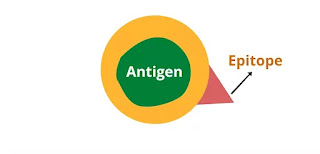What are Epitopes, Definition, Types, Numbers and Roles
Epitopes are the special chemical group present on antigen molecules that determine antigen specificity, They are rich in charged polar amino acids and mostly form a ring structure. According to their structural characteristics, they are usually divided into linear and conformational epitopes.
Among them, conformational epitopes located on the surface of antigen molecules account for the vast majority of antigenic epitope. A conformational epitope is a type of epitope in which a specific conformation is formed in space by natural polypeptides (containing 5-17 amino acids) or polysaccharide residues (5-7 monosaccharides, nucleotides), etc.
What are Epitopes, Definition, Types, Numbers, and Roles:
Epitope Definition:
- Epitopes or antigenic determinants are regions of Antigens that can trigger an immune response mediated by B cells or T cells.
- Epitopes or Antigenic determinants are any substance that is capable of triggering the immune response, more specifically, inducing the formation of antibodies.
- An epitope is a part of the antigen recognized by an antibody.
- An epitope is the portion of an antigen recognized by the immune system, specifically the sequence to which antibodies bind and generate an immune response.
What are Epitopes?
- An epitope or antigenic determinant is the part of an antigen that is recognized by the immune system and generates an immune response.
- The causative substance that causes the disease is called an antigen and the substance that sticks to it is called an antibody.
- Epitope binds to a specific antigen receptor present on the surface of a B cell and Binding between this receptor and epitope occurs only if their structures are complementary.
- Many antigens have a variety of distinct epitopes on their surfaces. Each epitope is capable of reacting with a different B cell antigen receptor.
- One antibody can bind to only one type of epitope. On the other hand, antigens usually have multiple epitopes in their molecule.
- There are two types of Epitopes Continuous Epitopes and Discontinuous Epitopes.
- Linear epitopes are made up of consecutive amino acid sequences.
- Structural epitope are recognized as antigens that are structurally close to each other due to protein folding.
- They are composed of Proteins when heat is applied epitopes can be denatured.
- Both B and T cells can recognize epitopes on antigens, but the nature of the epitopes is different in both cases.
- B cells can recognize soluble antigens bound to membrane-bound antibodies. Thus, epitopes have highly accessible sites on the exposed surface of the immunogen.
- T cells cannot recognize any random antigen. They interact with the portion of the antigen presented by a special molecule called the MHC (major histocompatibility complex) on antigen-presenting cells or nucleated cells.
Types of Epitopes:
There are two types of Epitopes based on Amino acid Sequences Continuous and Discontinuous Epitopes.
1. Continuous or linear epitope: These types of epitopes have short sequences of adjacent amino acids of a protein.
2. Discontinuous or modulatory epitope: These types of epitope only exist when the protein is folded into a specific modulation. These are composed of amino acids which are not contiguous in the primary sequence but are located nearby within the structure of the folded protein.
Number of Antigenic Determinants:
The number of Antigenic determinants of various antigens is different, for example, diphtheria toxoid has 8 antigenic determinants and influenza virus has more than 40 antigenic determinants. Most of the antigenic determinants exist on the surface of the antigen, but some are hidden inside the antigen.
For example, bovine serum albumin has more than 18 antigenic determinants, but only 6 are exposed on the surface of the antigen. The antigenic determinants hidden inside the antigen molecule are generally nonfunctional. Under the action of the enzyme, the antigenic molecule exposes the internal antigenic determinant, to play the role of the antigenic determinant.
B and T cell Epitope:
An epitope is a site or region on an antigen that is recognized as a foreign substance by an antibody. They are also known as antigenic determinants, which are immunologically active regions that bind to the immune system or antigen-specific membrane receptors that secrete antibodies.
Characteristics of B cell epitopes :
- Antigens that trigger B cell immune response can be proteins, carbohydrates, lipids, and Adjuvants such as trinitrophenol, etc.
- They are generally composed of hydrophilic amino acids or proteins that are ready to bind with antibodies.
- The B cell epitope has a complementary shape to the antigen-binding site that is present on the antibody. This is necessary because the interaction between antigen and antibody is weak.
- The size of the epitope should not be larger than the receptor.
- They are recognized directly by antibodies and not by way of presentation through another protein molecule.
- B cell epitope can comprise sequential or non-sequential amino acids.
- These Antigenic determinants tend to exhibit site mobility and are present inflexible regions.
- Surface immunoglobulins associated with B cells and free antibodies recognize surface antigen epitopes in their natural three-dimensional form.
Characteristics of T cell epitope:
- These are processed and presented to T cells via the MHC I and MHC II complexes.
- T-cell receptors cannot bind free peptides or antigens.
- Unlike B-cell epitopes, T-cell epitopes can be internal and can have hydrophobic amino acid sequences.
- T cells recognize epitopes of antigens that have been processed by specific cells (antigen-presenting cells) that are conjugated to major histocompatibility complex molecules.
- When antigenic peptides processed by APCs or nucleated cells interact with T cell receptors, a trimolecular complex can be observed – MHC class II + peptide + T cell receptor.
- Recognition of Epitope by B-cell and T-cell is central to humoral and cell-mediated immune response.
- They are central to vaccine design, infectious disease prevention, disease diagnosis, and treatment.

